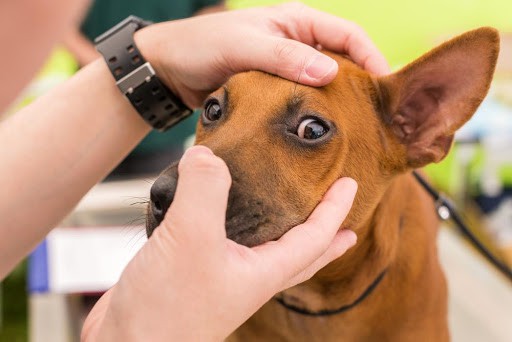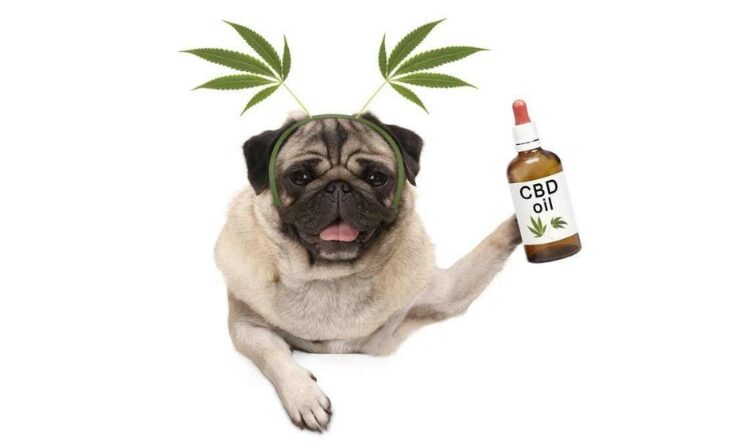4 Common Eye Problems in Dogs

Veterinary ophthalmology is a specialized medical practice that diagnoses and treats eye conditions in pets. Primary veterinarians can treat many problems and injuries related to the eyes, but major eye diseases and conditions are reserved for veterinary ophthalmologists. Dogs and humans have almost identically structured eyes, which means they develop the same age-related issues. Glaucoma, cataracts, and dry eye are all common among older dogs. In addition to age-related eye conditions, a dog can also injure their eyes or developmental abnormalities.
-
Corneal Trauma
Dogs explore environments leading with their heads. This makes their eyes susceptible to trauma and injury. Foreign objects can scratch or puncture the cornea, which is the clear outer part of the eye. Cornea injuries are incredibly painful, and if they are not treated right away, they can cause permanent damage.
Certain breeds are more susceptible to corneal trauma. For example, flat-faced breeds suffer from corneal exposure, so they are more likely to experience injuries from foreign objects. These breeds include Pugs, Shih Tzus, and Bulldogs. Signs of trauma to the cornea include squinting, holding the eyes close, tearing, and redness. To diagnose a corneal injury, the ophthalmologist will stain the cornea with a fluorescein dye, which will detect any surface injuries. The treatment of corneal trauma will depend on the severity of the damage. Small scratches can be treated by a primary veterinarian, who will prescribe eye drops. Major punctures should be treated by a specialist and may require surgery.
-
Glaucoma
Glaucoma is the result of rising pressure within the eye called intraocular pressure. The eye condition is primarily inherited but does not typically develop until later in the dog’s life. Breeds that are most likely to develop glaucoma are Basset Hound, Beagle, Chihuahua, Chow Chow, Cocker Spaniel, Dachshund, Maltese, Miniature Poodle, Samoyed, and Siberian Husky. Other causes of glaucoma in dogs include infection, injury, or tumors. In patients with Glaucoma, intraocular pressure damages the optic nerve and can result in blindness. Signs of glaucoma are redness, a larger-than-normal eye, cloudiness, and pain. Intraocular pressure is measured using a tonometer. The vet will numb the dog’s cornea then gently touch the tonometer to the surface of the eye. The ophthalmologist will conduct further tests to determine the cause and treatment of glaucoma. The treatment of glaucoma in dogs depends on the cause and severity of the disease. Medications can delay progression and ease the pain, but without surgery, dogs are likely to lose their eyesight within a couple of years. Unfortunately, dogs are still at risk of blindness after the operation, so the benefits and risks of surgery should be carefully weighed.
-
Cataracts

Cataracts are common among older dogs and appear as cloudiness of the pupil. Other symptoms of cataracts include eye irritation, redness, discharge, and blinking. Cataracts in dogs are caused by genetics, diabetes, aging, or congenital abnormalities. Although the eye disease ranges in severity, cataracts may interfere with vision, which then requires surgery. Before cataract surgery, the veterinary ophthalmologist will prefer several tests to ensure the patient is a good candidate for the procedure. Cataract surgery involves replacing the lens contents with a prosthetic lens. The operation has a high success rate and restores the patient’s vision immediately.
-
Eyelid Abnormalities
Eyelid abnormalities are hereditary, and certain breeds are more prone to entropion and ectropion, which are conditions of abnormal eye length. Entropion is when animals have a short eyelid that curls inward, causing potential injury or infection to the cornea. Entropion is common in certain dog breeds, such as Chow Chow, Rottweiler, Great Dane, Saint Bernard, Shar-Pei, and Bullmastiff.
Dogs with ectropion have longer eyelashes than normal. In patients with ectropion, tears do not spread over the cornea, causing dry, red eyes. Dog breeds that are susceptible to ectropion include Saint Bernard, Great Dane, Bloodhound, Bullmastiff, and Newfoundland.
Both entropion and ectropion usually require reconstruction surgery. The ophthalmologist will reconstruct the eyelid, so it makes appropriate contact with the eyeball, preventing any further infections or injuries.
The best way to prevent eye problems in your dog is to take them in for periodic exams. Your primary veterinarian will be able to see the first signs of a developing condition. Signs of eye disease or injury in pets include red eye, tearing, squinting, discharge, rubbing at the eye or face, blinking, and cloudiness. If your dog is showing any of these signs, it could indicate there is an underlying issue. Prompt attention is the key to avoiding complications and maintaining your dog’s eye health.
What's Your Reaction?
Newly middle-aged wife of 1, Mom of 3, Grandma of 2. A professional blogger who has lived in 3 places since losing her home to a house fire in October 2018 with her husband. Becky appreciates being self-employed which has allowed her to work from 'anywhere'. Life is better when you can laugh. As you can tell by her Facebook page where she keeps the humor memes going daily. Becky looks forward to the upcoming new year. It will be fun to see what 2020 holds.








